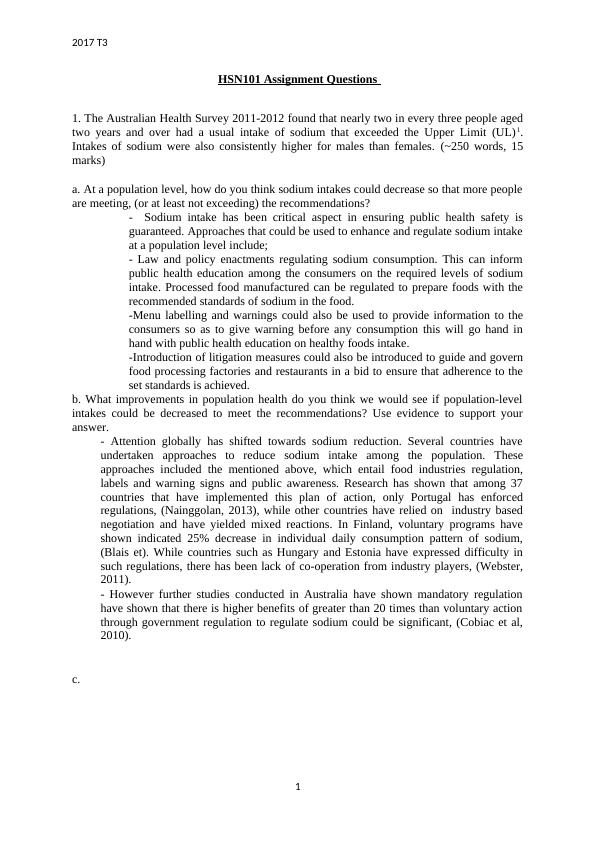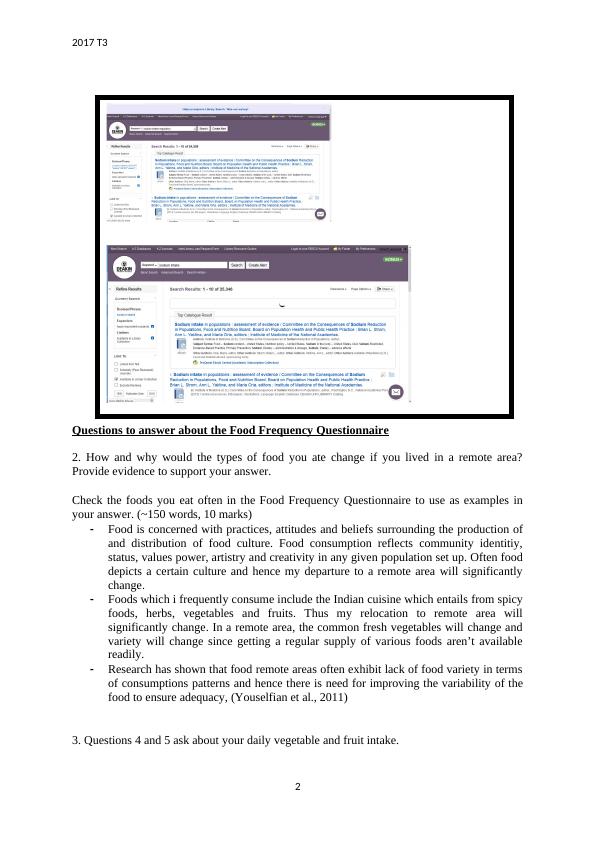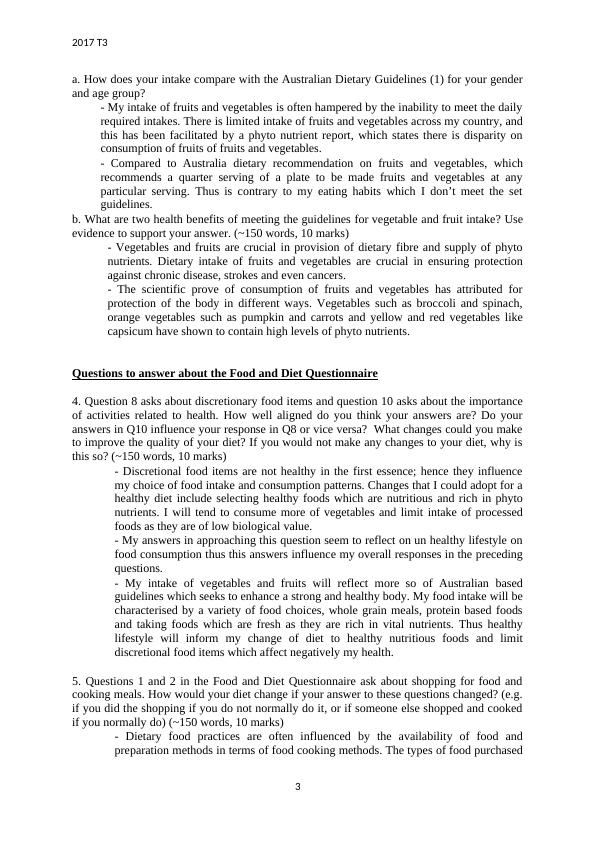Ask a question from expert
HSN101 Foundations of Food, Nutrition and Health Assignment
7 Pages2889 Words256 Views
Foundations of Food, Nutrition and Health (HSN101)
Added on 2020-05-28
HSN101 Foundations of Food, Nutrition and Health Assignment
Foundations of Food, Nutrition and Health (HSN101)
Added on 2020-05-28
BookmarkShareRelated Documents
2017 T3HSN101 Assignment Questions 1. The Australian Health Survey 2011-2012 found that nearly two in every three people agedtwo years and over had a usual intake of sodium that exceeded the Upper Limit (UL)1.Intakes of sodium were also consistently higher for males than females. (~250 words, 15marks)a. At a population level, how do you think sodium intakes could decrease so that more peopleare meeting, (or at least not exceeding) the recommendations?- Sodium intake has been critical aspect in ensuring public health safety isguaranteed. Approaches that could be used to enhance and regulate sodium intakeat a population level include;- Law and policy enactments regulating sodium consumption. This can informpublic health education among the consumers on the required levels of sodiumintake. Processed food manufactured can be regulated to prepare foods with therecommended standards of sodium in the food.-Menu labelling and warnings could also be used to provide information to theconsumers so as to give warning before any consumption this will go hand inhand with public health education on healthy foods intake.-Introduction of litigation measures could also be introduced to guide and governfood processing factories and restaurants in a bid to ensure that adherence to theset standards is achieved.b. What improvements in population health do you think we would see if population-levelintakes could be decreased to meet the recommendations? Use evidence to support youranswer. - Attention globally has shifted towards sodium reduction. Several countries haveundertaken approaches to reduce sodium intake among the population. Theseapproaches included the mentioned above, which entail food industries regulation,labels and warning signs and public awareness. Research has shown that among 37countries that have implemented this plan of action, only Portugal has enforcedregulations, (Nainggolan, 2013), while other countries have relied on industry basednegotiation and have yielded mixed reactions. In Finland, voluntary programs haveshown indicated 25% decrease in individual daily consumption pattern of sodium,(Blais et). While countries such as Hungary and Estonia have expressed difficulty insuch regulations, there has been lack of co-operation from industry players, (Webster,2011).- However further studies conducted in Australia have shown mandatory regulationhave shown that there is higher benefits of greater than 20 times than voluntary actionthrough government regulation to regulate sodium could be significant, (Cobiac et al,2010).c. 1

2017 T3Questions to answer about the Food Frequency Questionnaire2. How and why would the types of food you ate change if you lived in a remote area?Provide evidence to support your answer. Check the foods you eat often in the Food Frequency Questionnaire to use as examples inyour answer. (~150 words, 10 marks)-Food is concerned with practices, attitudes and beliefs surrounding the production ofand distribution of food culture. Food consumption reflects community identitiy,status, values power, artistry and creativity in any given population set up. Often fooddepicts a certain culture and hence my departure to a remote area will significantlychange.-Foods which i frequently consume include the Indian cuisine which entails from spicyfoods, herbs, vegetables and fruits. Thus my relocation to remote area willsignificantly change. In a remote area, the common fresh vegetables will change andvariety will change since getting a regular supply of various foods aren’t availablereadily.-Research has shown that food remote areas often exhibit lack of food variety in termsof consumptions patterns and hence there is need for improving the variability of thefood to ensure adequacy, (Youselfian et al., 2011)3. Questions 4 and 5 ask about your daily vegetable and fruit intake. 2

2017 T3a. How does your intake compare with the Australian Dietary Guidelines (1) for your genderand age group? - My intake of fruits and vegetables is often hampered by the inability to meet the dailyrequired intakes. There is limited intake of fruits and vegetables across my country, andthis has been facilitated by a phyto nutrient report, which states there is disparity onconsumption of fruits of fruits and vegetables. - Compared to Australia dietary recommendation on fruits and vegetables, whichrecommends a quarter serving of a plate to be made fruits and vegetables at anyparticular serving. Thus is contrary to my eating habits which I don’t meet the setguidelines. b. What are two health benefits of meeting the guidelines for vegetable and fruit intake? Useevidence to support your answer. (~150 words, 10 marks)- Vegetables and fruits are crucial in provision of dietary fibre and supply of phytonutrients. Dietary intake of fruits and vegetables are crucial in ensuring protectionagainst chronic disease, strokes and even cancers.- The scientific prove of consumption of fruits and vegetables has attributed forprotection of the body in different ways. Vegetables such as broccoli and spinach,orange vegetables such as pumpkin and carrots and yellow and red vegetables likecapsicum have shown to contain high levels of phyto nutrients.Questions to answer about the Food and Diet Questionnaire4. Question 8 asks about discretionary food items and question 10 asks about the importanceof activities related to health. How well aligned do you think your answers are? Do youranswers in Q10 influence your response in Q8 or vice versa? What changes could you maketo improve the quality of your diet? If you would not make any changes to your diet, why isthis so? (~150 words, 10 marks)- Discretional food items are not healthy in the first essence; hence they influencemy choice of food intake and consumption patterns. Changes that I could adopt for ahealthy diet include selecting healthy foods which are nutritious and rich in phytonutrients. I will tend to consume more of vegetables and limit intake of processedfoods as they are of low biological value. - My answers in approaching this question seem to reflect on un healthy lifestyle onfood consumption thus this answers influence my overall responses in the precedingquestions. - My intake of vegetables and fruits will reflect more so of Australian basedguidelines which seeks to enhance a strong and healthy body. My food intake will becharacterised by a variety of food choices, whole grain meals, protein based foodsand taking foods which are fresh as they are rich in vital nutrients. Thus healthylifestyle will inform my change of diet to healthy nutritious foods and limitdiscretional food items which affect negatively my health.5. Questions 1 and 2 in the Food and Diet Questionnaire ask about shopping for food andcooking meals. How would your diet change if your answer to these questions changed? (e.g.if you did the shopping if you do not normally do it, or if someone else shopped and cookedif you normally do) (~150 words, 10 marks) - Dietary food practices are often influenced by the availability of food andpreparation methods in terms of food cooking methods. The types of food purchased3

End of preview
Want to access all the pages? Upload your documents or become a member.
Related Documents
(PDF) Salt Reduction Initiatives around the Worldlg...
|16
|4933
|59
Regulating Sugar Labeling on Packaged Foods and Drinkslg...
|9
|2117
|79
Nutrition for Special Populationslg...
|4
|567
|23
Childhood Obesity in Australia: Inequity between Indigenous and Non-Indigenous Australianslg...
|8
|2232
|5